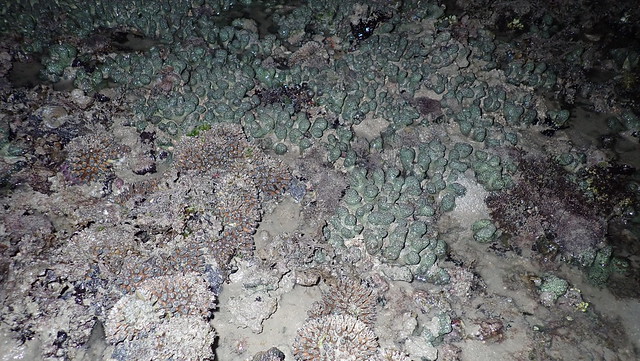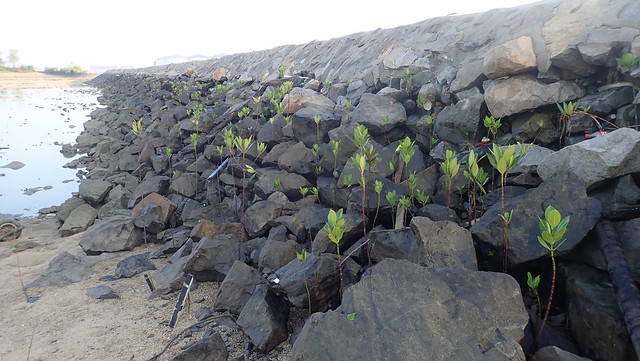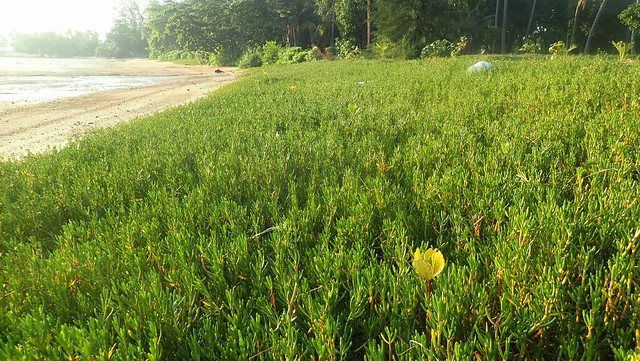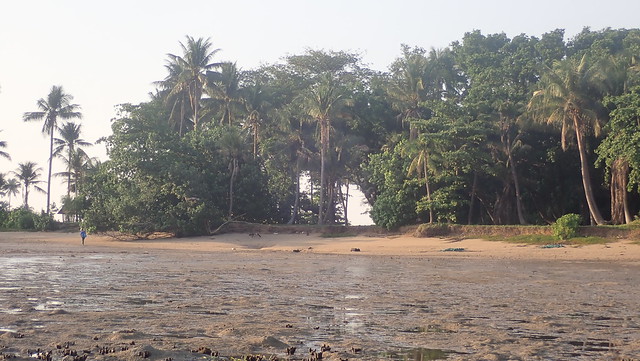Our first time surveying Pulau Hantu since it was closed due to asbestos in May 2018. This March, it was announced that all asbestos has been cleared from the Southern Islands!
Although it lies just across the petrochemical plants on Pulau Bukom, there are living reefs, seagrasses and even mangroves on Pulau Hantu. It was great to see the corals doing so well, with lots of Sunflower mushroom corals! Although some corals that were not looking well.
The last time I surveyed the western reef edge was in Aug 2015. Just as that time, there were lots and lots of mushroom corals. Circular mushroom corals were crowded together in some areas!
I also saw Tongue mushroom corals, Feather mushroom corals, Oval mushroom corals and Mole mushroom corals!
But the most heartening was to see many (more than 20) Sunflower mushroom corals. These are not commonly seen on our shores. Certainly, not in such abundance these days.
Even though it was dark as the minimum tide happened well before sunrise, I was glad to see some of the special corals were still thriving at the reef edge. Like the bright blue branching Horn coral.
There large clusters of large colonies of various corals. Including some kinds of corals that I don't see very often. They were all healthy and not bleaching.
There were large areas covered by Anemone corals (green ones in the photo) and Galaxy corals (brown ones). The two kinds 'met' at one part of the shore. I wonder what kind of battles go on in this border.
I was glad to see healthy colonies of these kinds of corals that were the first to bleach during the last mass coral bleaching event. But all the Flowery disk corals I saw were very pale.
As usual, Merulinid corals were the most common. Most that I saw were alright but I saw some with pale patches and a few were bleaching.
I saw some Boulder pore corals that were pale, and some had dying or recently dead patches. There were many small to medium sized colonies of leathery soft corals of various kinds. They were not bleaching. I also saw several Asparagus flowery soft corals, all looked alright, although some were a little pale.
Despite being obsessed with the corals, I also noticed some Giant carpet anemone (with anemonefish which were shy) and I saw one Magnificent anemone, I saw a really huge Saw-edged spooner crab. Once again, I saw a humungous Upsidedown jellyfish. At first I thought it was a sea anemone until I saw it weakly pulsating. We also saw feather stars. There were Common sea stars in the southern lagoon, and in the northern lagoon I saw a very large living Fan shell clam.
I saw a few common nudis and a Ceratosoma gracillimum, And a Dawn flatworm.
After the sun rose, I could check the mangroves settling on the seawalls here. For the first time, I had a look at the southern lagoon on Hantu Besar and was glad to see some mangrove trees settling on the seawall there.
It was particularly nice to see several small but healthy Tengar putih, one was already bearing flowers and propagules.
The bigger trees on the western side of the northern lagoon seemed alright from a distance (I just couldn't make it to walk nearer).
On the eastern side of the northern lagoon, there were lots and lots of young Bakau (Rhizophora) saplings, and a few other kinds higher up on the water line.
I also noticed many Bakau (Rhizophora) saplings had settled in the dense carpet of Gelang laut that line the two lagoons I surveyed today.
The Tape seagrass appears sparser than before in the northern lagoon. While I did come across cropped Tape seagrasses, most of those I saw were long. There were sprinkles of Spoon seagrasses, most of them heavily covered in ephiphytes. This is similar to what I saw in Aug 2017, Aug 2015 and Jan 2017.
There was an abandoned net in the southern lagoon, but I was alone there and the net was already encrusted with seaweeds. No animals were trapped in it. So I left it there.
Like most of our recreational islands, Pulau Hantu was reclaimed. There appears to be severe erosion on the northern shoreline of Hantu Besar.
The emissions from the refinery on Pulau Bukom is more obvious in the rising sun.
The 2030 Landuse Plan by the Ministry of National Developmentreleased in Jan 2013 shows plans for 'possible future reclamation' (in light blue surrounded by dotted lines) that may obliterate Pulau Hantu. More about the possible impact of the 2030 Landuse Plan on our shores.
The Singapore Blue Plan 2018
Pulau Semakau and nearby islands and submerged reefs have been recommended by the Singapore Blue Plan 2018 for Immediate Conservation Priority.
The Blue Plan recommends the intertidal and subtidal marine areas of Pulau Semakau and adjacent Pulau Hantu, and Pulau Jong to be designated Marine Reserve.
The Blue Plan highlights that Pulau Semakau and its associated patch reefs comprise many ecosystems: coral reefs, mangrove areas, intertidal sandflats, seagrass meadows, and coral reefs. The subtidal area of Pulau Jong is larger than the terrestrial area. Pulau Hantu is a popular dive site has seen increasing interest in the past decade due to biodiversity awareness. If protection is accorded to these three islands, zonation plans for use can be implemented to manage tourism and human impacts.
DOWNLOAD the Plan, SUPPORT the Plan! More on the Singapore Blue Plan 2018 site.
Photos by others on this trip:
Chay Hoon
Jianlin Liu
Loh Kok Sheng
Kelvin Yong
Joleen Chan
Marcus Ng
Jesselyn Chua
Others on this trip: Juria, Lisa.























